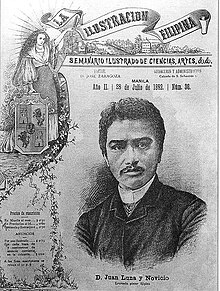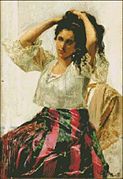Juan Luna
Juan Luna y Novicio (born October 23, 1857 in Badoc , † December 7, 1899 in Hong Kong ) was a Filipino painter who was well-known beyond the country's borders . He was the brother of Antonio Luna , a general and folk hero of the island state. Juan Luna himself is also one of the most important personalities that the Philippines has produced.
Early years
He was born on October 23, 1857 in Badoc, Ilocos Norte , the third of seven children of Joaquin Luna de San Pedro y Posada and Laurena Novicio y Ancheta. Juan Luna attended the Ateneo de Manila and showed his interest and talent for painting early on. In 1874 he obtained his degree as a Bachelor of Art (Bachelor of Art). In addition, he studied navigation in the Escuela Nautica de Manila and went as a seaman to various ports around the world. Whenever his ship stopped in the port of Manila, however, he took painting lessons from Agustin Saiz at the Academia de Dibujo y Pintura.
education
Don Lorenzo Guerero, who recognized Luna’s natural talent early on, was the young man’s first tutor . He persuaded his parents to send their son to Spain in order to be able to deepen his education there. Juan finally traveled to Barcelona in 1877 with his older brother Manuel, a violinist . When he arrived in Spain, he finally gave up seafaring and enrolled in the Escuela de Bellas Artes de San Fernando in Madrid , where after a short time he was able to win the only academic award at this school. Not satisfied with the teaching content of the school, he took private lessons from Alejo Vera, a well-known contemporary Spanish painter. His teacher quickly thought very highly of his new student and took him on study trips to Rome and Paris .

In Rome, Luna expanded his art knowledge by studying the immortal works of the masters of the Renaissance . In the Italian capital he painted his picture Daphne y Cleo , for which he received a silver palette from the Liceo Artistico de Manila. He received another award for his work La Muerte de Cleopatra (Cleopatra's Death), which was awarded a silver medal. This picture was later acquired by the Spanish government for one thousand duros (5000 pesetas). (The 5 peseta coin was colloquially known as “duro”).
Success in Spain
Luna's growing fame soon reached his homeland as well. In recognition of his performance and the services that resulted from it, the Philippine government granted him a "pensionado", an alimony of six hundred pesos annually for a total of four years. He then painted three canvases for the Spanish government: The Blood Compact , Don Miguel Lopez de Legazpi and a portrait of Governor Ramon Blanco .
While he was still in Rome, he worked incessantly on his most important work, Spoliarium . For this he received in 1884, along with another Filipino artist, Felix Resurreccion Hidalgo, first prize in Madrid, the gold medal of the National Exposition of Fine Arts. His painting Battle of Lepanto ("Battle of Lepanto") won another gold medal in the Barcelona Exposition in 1888.
Because of their success, he and Hidalgo were soon honored by the Filipinos studying in Spain, including that of José Rizal , who would later be regarded as the most important personality in Filipino history.
France
In 1885 Luna went to Paris and set up a studio at 65 Boulevard Arago, in close proximity to that of Hidalgo. As with Hidalgo, Luna's studio quickly became a hangout for the Filipino community in Paris. It was here that Rizal, together with other young Filipinos, organized the Indios Bravos , an association of anti-colonial foreign Filipinos.
In the following year, 1886, he married Paz Pardo de Tavera, with whom he had a son, Andres, and a daughter, Maria de la Paz, who, however, died early. The marriage ended tragically. In a fit of jealousy, he killed his wife and mother-in-law on September 23, 1892 and seriously injured his brother-in-law Felix. His case was heard in the French court in 1893; on February 7, he was acquitted of charges of parricide and murder. Five days later he left Paris and went to Madrid with his son, where he finished some of his works.
Return to the Philippines
On April 27, 1894, after an absence of 17 years, he returned to the Philippines. Here he made some works with Filipino scenes. In spring 1896 he left his homeland again, this time for Japan . When he returned a few weeks later, he was arrested on September 16, 1896 and imprisoned in the Fuerza de Santiago in Manila for almost two years. The Spaniards accused him of participating in the Katipunan revolt, in which his brother Antonio played a leading role. On May 27, 1897, in honor of the birthday of King Alfonso XIII , he was pardoned. The following month he left the Philippines again and went back to Spain.
Member of the Paris delegation
In 1898 the Executive Committee of the Philippine Revolutionary Government appointed him a member of the Paris delegation that worked on diplomatic recognition of the Philippine Republic. When the Treaty of Paris was signed on December 10, 1898, thus sealing the Spanish-American War , he traveled to Washington, DC as a member of the delegation to urge the American government to recognize the Philippine government and the sovereignty of the republic.
When the news of his brother Antonio's death reached him, he traveled home as quickly as possible. He got there via Hong Kong , where he suffered a heart attack on December 7, 1899 and died before medical help arrived. He was buried in Hong Kong and exhumed in 1920 . The body was transferred to his son in the Philippines, who gave him his final resting place in the crypt of the Chapel of San Agustin.
Luna's fame and works
Luna's fame reached far into the western world. He was cheered and celebrated both in Europe and in his homeland. When he was viewed skeptically by some Spaniards due to his origins, Rizal defended him with the words:
- "Genius has no land, genius erupts everywhere, is like light and air - a paternal inheritance of everything, more cosmopolitan than space, than life, than God."
Here is a list of some of Luna's works:
|
|
In honor of Juan Luna, a main street and a school were named after him in Manila.
His most important work, Spoliarium , is now in the Manila National Museum.
Web links
- Extensive biography of Juan Luna
- Biography of Juan Luna ( Memento of November 4, 2007 in the Internet Archive )
- Biography of the national hero Juan Luna
- Images Juan Lunas
| personal data | |
|---|---|
| SURNAME | Luna, Juan |
| ALTERNATIVE NAMES | Luna y Novicio, Juan |
| BRIEF DESCRIPTION | Filipino painter and national hero |
| DATE OF BIRTH | October 23, 1857 |
| PLACE OF BIRTH | Badoc |
| DATE OF DEATH | December 7, 1899 |
| Place of death | Hong Kong |





